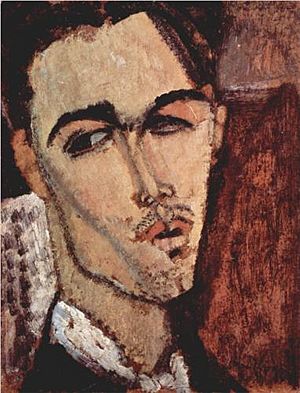Celso Lagar facts for kids
Quick facts for kids
Celso Lagar
|
|
|---|---|
 |
|
| Born |
Celso Lagar Arroyo
February 4, 1891 |
| Died | September 6, 1966 (aged 75) |
| Nationality | Spanish |
| Known for | Painting, Sculpture |
| Movement | First Generation School of Paris |
| Spouse(s) | Hortense Begué |
Celso Lagar Arroyo was a talented Spanish painter. He was born in 1891. He became known as one of the first Spanish expressionist painters from the "School of Paris." This was a group of artists who lived and worked in Paris, France. Celso Lagar spent most of his life there. His art was inspired by styles like Cubism and Fauvism.
Contents
Biography
Early Life and Art Studies
Celso Lagar Arroyo was born in a small city called Ciudad Rodrigo in Spain. When he was young, he moved to Madrid. There, he joined the workshop of Miguel Blay, a famous sculptor.
In 1910 and 1911, Celso visited Barcelona. Later, in 1911, he went to Paris to study sculpture. This was a suggestion from his mentor, Miguel Blay. In Paris, he met other artists like Joseph Bernard and Amedeo Modigliani. He also met Hortense Begué, a French sculptor who would later become his wife. Around this time, Celso slowly stopped focusing on sculpture. He decided to become a painter instead.
Life and Art in Paris
The start of the First World War in 1914 changed Celso Lagar's life and art. He stayed in Barcelona during the war. His work became quite popular there. This success allowed him to return to Paris after the war ended. In 1919, he settled permanently in France.
His paintings were shown in many important art galleries in Paris. At first, his art was influenced by new styles like Cubism and Fauvism. But Celso Lagar soon found his own special way of painting. People said his later works showed influences from famous artists like Goya and Picasso. His unique style was very popular with both critics and the public.
Later Years and Challenges
When the Second World War began, life became very hard. Celso Lagar and his wife, Hortense, had to seek safety in the French Pyrenees mountains. They faced many difficulties and struggled with money.
Sadly, Hortense became ill and passed away in 1955. Celso Lagar was very sad after her death. He became deeply depressed and needed help. He was admitted to the Sainte Anne asylum, a place that offered care for mental health. During this time, it became harder for him to create art. To help pay for his care, some of his remaining artworks were sold at auctions. In October 1964, he returned to Seville, Spain. He lived with his sister until he passed away on September 6, 1966.
Works
Celso Lagar's paintings are displayed in many museums across Europe. You can find his art in places like:
- La Rochelle in France
- The Goya Museum in Castres, France
- Honfleur in France
- The Petit-Palais in Geneva, Switzerland
- The Museo Nacional Centro de Arte Reina Sofía in Madrid, Spain
- The Lis House in Salamanca, Spain
- The Carmen Thyssen Museum in Málaga, Spain
His works are also part of important private collections, like Crane Kalman in London and Zborowski in Paris.
Famous Paintings
Some of Celso Lagar's well-known paintings include:
- La vida en el campo (Life in the Country)
- El Retrato de Xavier Montsalvatge (The Portrait of Xavier Montsalvatge)
- Ensayo de luz por el planismo o Retrato de nena (Essay of Light through Planism and Portrait of a Girl)
- Arlequins (Harlequins)
- Jeune acrobate (Young Acrobat)
- Clowns et haltérophiles (Clowns and Weightlifters)
- Les bohémiens (Gypsies)
See also
 In Spanish: Celso Lagar para niños
In Spanish: Celso Lagar para niños

